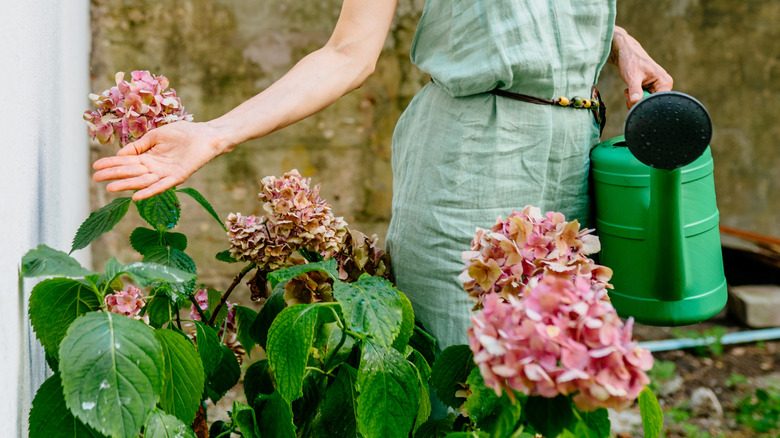The Crucial Hydrangea Winter Prep Task You Shouldn't Forget
As the weather outside grows frightful, you'll want to make sure your plants are safe before settling down by a fire that's so delightful. Overwintering is a catch-all term you've undoubtedly heard for the steps gardeners take to protect newly-planted, frail, or heat-loving plants from months of cold weather. In some cases, overwintering involves digging up and moving plants indoors or under cover. Hydrangeas, whether new wood or old wood species, are perennial, so they simply go dormant wherever they're planted. Most survive in their beds as buds on leafless branches, waiting to sprout and bloom once again next season. However, just because you know these plants will stop growing at the first sign of cold, there's a fall trick for successful hydrangea blooms every year that's worth doing: deep watering.
Overwintering hydrangea buds die for numerous reasons, including frosts that arrive later than expected or major winter weather events. This can prevent flowering next season, even if some buds survive. However, most hydrangea plants will live through the cold months just fine with a little help. There is an ideal method for watering hydrangeas in the fall. Hydrangeas love water, so apply it generously using a watering can, garden hose, soaker hose, or drip-watering bag. Water to a depth of at least 3 inches before the first frost. This ensures their roots are sufficiently hydrated to last them through until next spring. Dormant hydrangeas will wither and even die if they don't get enough water in fall. If you garden below Zone 7, water once in fall. Gardeners growing hydrangeas in Zones 7 and up can water twice.
More essential fall hydrangea care to maximize watering
Your hydrangea shrubs should be watered right at their base rather than from overhead. Splashes of water on the leaves can move harmful pathogens from one part of the plant to another. However, you also want to be careful not to overwater your hydrangeas or you risk that they will develop moisture-related diseases like root rot. If you decide to relocate your hydrangeas indoors for the winter, continue watering the dormant shrubs once every two or three weeks, especially if the space is unheated. Don't allow young family members or pets access to the plants. Hydrangeas are poisonous when consumed in large quantities.
Outside of watering to the right depth in the fall, laying mulch or straw around your hydrangeas helps the soil stay moist. As a bonus, it insulates the ground from winter's chill. It's important to put your mulch down at the right time. Early fall application could stop the shrubs going dormant, whereas leaving it too late might mean the ground is already frozen. If you're worried about your plant's winter survival, wrap the naked branches in burlap or wire enclosures filled with leaves, which act as insulation. There are also plenty of mistakes to avoid at all costs when winter-proofing your hydrangeas, such as pruning them in the late summer or fall, which removes future flower buds. Don't want to deal with the hassle of fall care? Some bigleaf hydrangea (Hydrangea macrophylla) cultivars are more winter hardy than others, so you can find options that better fit your gardening style and commitment levels.

